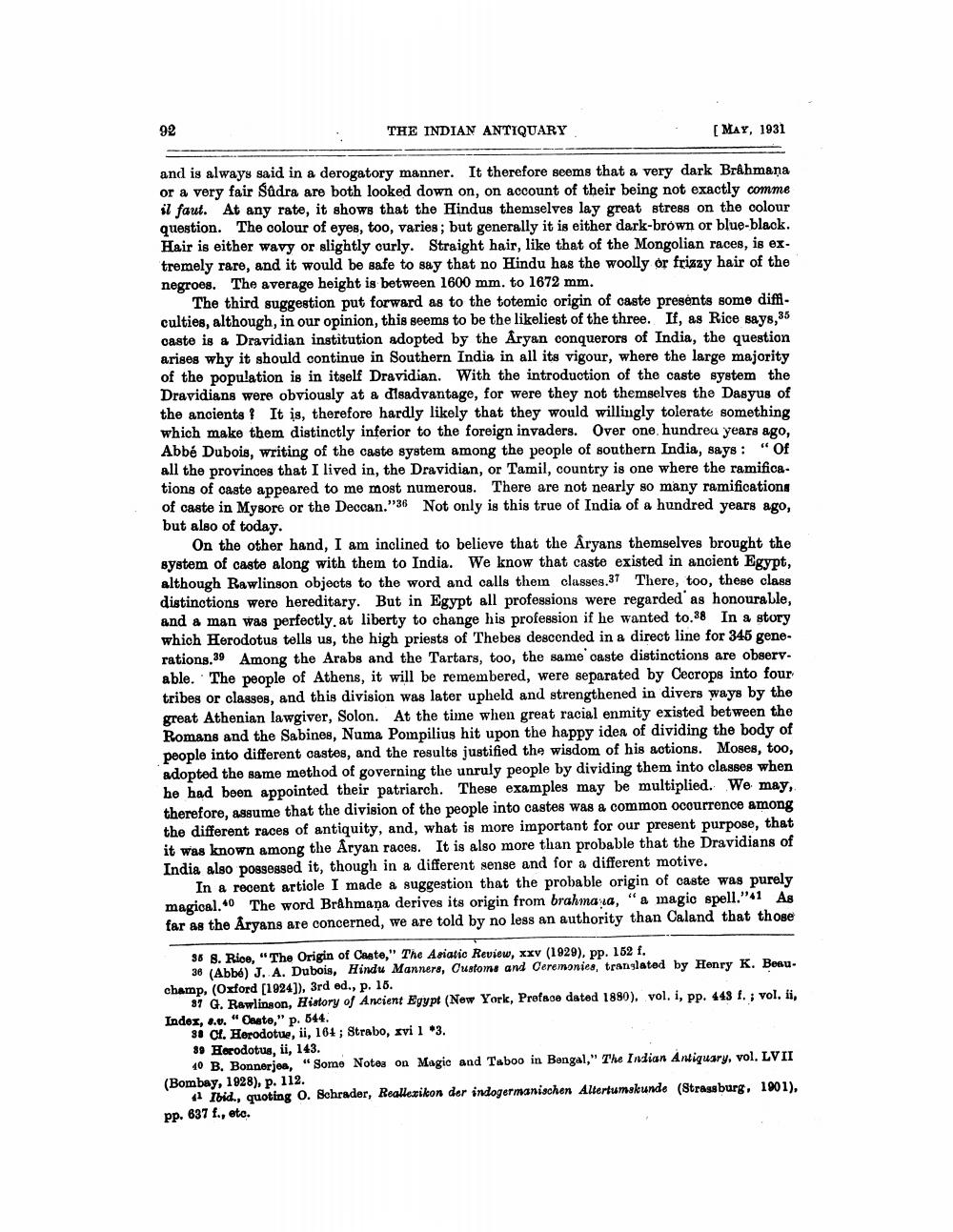________________
THE INDIAN ANTIQUARY
[MAY, 1931
and is always said in a derogatory manner. It therefore seems that a very dark Brahmana or a very fair Sadra are both looked down on, on account of their being not exactly comme il faut. At any rate, it shows that the Hindus themselves lay great stress on the colour question. The colour of eyes, too, varies; but generally it is either dark-brown or blue-black. Hair is either wavy or slightly curly. Straight hair, like that of the Mongolian races, is extremely rare, and it would be safe to say that no Hindu has the woolly or frizzy hair of the negroes. The average height is between 1600 mm. to 1672 mm.
The third suggestion put forward as to the totemic origin of caste presents some difficulties, although, in our opinion, this seems to be the likeliest of the three. If, as Rice says,35 caste is a Dravidian institution adopted by the Aryan conquerors of India, the question arises why it should continue in Southern India in all its vigour, where the large majority of the population is in itself Dravidian. With the introduction of the caste system the Dravidians were obviously at a disadvantage, for were they not themselves the Dasyus of the ancients ! It is, therefore hardly likely that they would willingly tolerate something which make them distinctly inferior to the foreign invaders. Over one hundred years ago, Abbé Dubois, writing of the caste system among the people of southern India, says: “Of all the provinces that I lived in, the Dravidian, or Tamil, country is one where the ramifications of caste appeared to me most numerous. There are not nearly so many ramifications of caste in Mysore or the Deccan."36 Not only is this true of India of a hundred years ago, but also of today.
On the other hand, I am inclined to believe that the Aryans themselves brought the system of caste along with them to India. We know that caste existed in ancient Egypt, although Rawlinson objects to the word and calls them classes.37 There, too, these class distinctions were hereditary. But in Egypt all professions were regarded as honourable, and a man was perfectly, at liberty to change his profession if he wanted to.38 In a story which Herodotus tells us, the high priests of Thebes descended in a direct line for 345 generations.39 Among the Arabs and the Tartars, too, the same oaste distinctions are observ. able. The people of Athens, it will be remembered, were separated by Cecrops into four tribes or classes, and this division was later upheld and strengthened in divers ways by the great Athenian lawgiver, Solon. At the time when great racial enmity existed between the Romans and the Sabines, Numa Pompilius hit upon the happy idea of dividing the body of people into different castes, and the results justified the wisdom of his aotions. Moses, too, adopted the same method of governing the unruly people by dividing them into classes when he had been appointed their patriarch. These examples may be multiplied. We may, therefore, assume that the division of the people into castes was a common courrence among the different races of antiquity, and, what is more important for our present purpose, that it was known among the Aryan races. It is also more than probable that the Dravidians of India also possessed it, though in a different sense and for a different motive.
In a recent article I made a suggestion that the probable origin of caste was purely magical. The word Brahmana derives its origin from brahmaia, "a magic spell."41 As far as the Aryans are concerned, we are told by no less an authority than Caland that those
38 8. Rice, "The Origin of Caste," The Asiatio Review, xxv (1929), pp. 152 1.
38 (Abbé) J. A. Dubois, Hindu Manners, Customs and Ceremonies, tranglated by Henry K. Besu. champ. (Oxford (1924]), 3rd ed., p. 15.
31 G. Rawlinson, History of Ancient Egypt (New York, Proface dated 1890), vol. I, pp. 443 1. ; vol. ii, Indor, ..0. " Caste," p. 544.
si Cl. Herodotue, ii, 161; Strabo, xvi 1 *3. 89 Herodotus, ii, 143.
40 B. Bonnerjea, "Some Notes on Magic and Taboo in Bengal," The Indian Antiquary, vol. LVII (Bombay, 1928), p. 112.
# Ibid., quoting O. Schrader, Reallexikon der indogermanischen Altertumskundo (Strassburg. 1901), pp. 637 f., etc.




